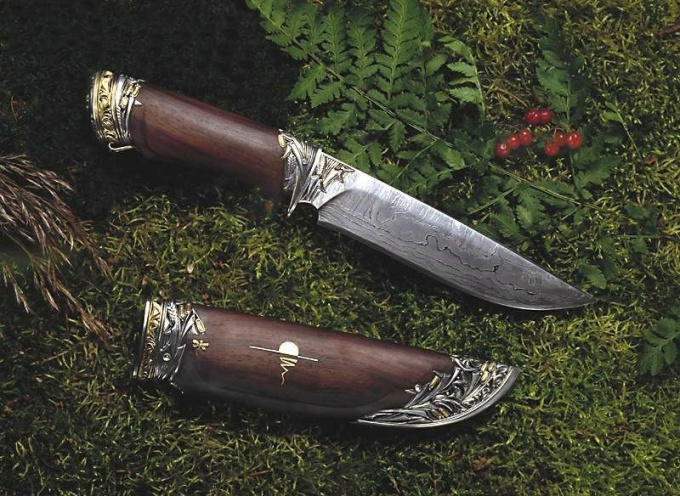Choosing a hunting knife is a rather complex task. Modern stores offer a huge selection. The main thing that distinguishes a hunting knife from the beautiful souvenir, it's made of a certain material.
The blades of the hunting knives are made of high-carbon steel. The hardness of the knife is measured in special units, which are designated HRC, and depends on the carbon content of the steel. It is necessary that the hardness of the hunting knife was not lower than 60 HRC. The higher the carbon content in the steel of the blade, the higher the hardness of the blade of the knife, and hence it retains the sharpness of the cutting surface.
About the amount of carbon in steel, you can find out by looking at the markings of a knife: 420 indicates less than 0.6%, While the 440 shows a 0.75%, 440 V contains 0.9%. The most popular steel, which made hunting knife – 440 S. Even with a relatively low hardness of the knife, this steel remains elastic. And the addition of components such as chromium and molybdenum, has excellent anti-corrosion properties. Easy to sharpen and retain the sharpness of the blade.
There are several alternatives to steel 440 C. the Most common of them is the CPM 440 V. This steel is produced by high temperature forging the powder mixture of metals. It perfectly holds the sharpening of a knife. Its durability is many times greater than traditional steel 440 C. But the big disadvantage of this knife – sharpening is quite complex.
No less famous are the 440 – 155 CM and ATS – 35. The first model is made from steel of American origin, the second Japanese. They are among the best modern steels. The hardness of such steels is 60 HRC. They have excellent flexibility and are easy to sharpen. The main disadvantages are low resistance to corrosion and relatively high cost of steel.
High demand the famous Damascus steel. It consists of bundles of steel rods, was forged in strips with a certain carbon content. A multiple number of times, these strips twisted, and then again prokovyvayut. The quality of the knife depends on the number of stripes. This complex process of treatment of steel gives it an incredibly high flexibility and strength.
The blade of a knife clearly visible unusually beautiful patterns. In quality it has no equal. The main drawback is its high price, reaching up to several hundred thousand rubles. Mostly knives of Damascus steel is made for Museum display. In everyday life, they quickly lose their beauty.
Criteria for the choice of steel for a hunting knife
The blades of the hunting knives are made of high-carbon steel. The hardness of the knife is measured in special units, which are designated HRC, and depends on the carbon content of the steel. It is necessary that the hardness of the hunting knife was not lower than 60 HRC. The higher the carbon content in the steel of the blade, the higher the hardness of the blade of the knife, and hence it retains the sharpness of the cutting surface.
About the amount of carbon in steel, you can find out by looking at the markings of a knife: 420 indicates less than 0.6%, While the 440 shows a 0.75%, 440 V contains 0.9%. The most popular steel, which made hunting knife – 440 S. Even with a relatively low hardness of the knife, this steel remains elastic. And the addition of components such as chromium and molybdenum, has excellent anti-corrosion properties. Easy to sharpen and retain the sharpness of the blade.
Types of steel for hunting knife
There are several alternatives to steel 440 C. the Most common of them is the CPM 440 V. This steel is produced by high temperature forging the powder mixture of metals. It perfectly holds the sharpening of a knife. Its durability is many times greater than traditional steel 440 C. But the big disadvantage of this knife – sharpening is quite complex.
No less famous are the 440 – 155 CM and ATS – 35. The first model is made from steel of American origin, the second Japanese. They are among the best modern steels. The hardness of such steels is 60 HRC. They have excellent flexibility and are easy to sharpen. The main disadvantages are low resistance to corrosion and relatively high cost of steel.
High demand the famous Damascus steel. It consists of bundles of steel rods, was forged in strips with a certain carbon content. A multiple number of times, these strips twisted, and then again prokovyvayut. The quality of the knife depends on the number of stripes. This complex process of treatment of steel gives it an incredibly high flexibility and strength.
The blade of a knife clearly visible unusually beautiful patterns. In quality it has no equal. The main drawback is its high price, reaching up to several hundred thousand rubles. Mostly knives of Damascus steel is made for Museum display. In everyday life, they quickly lose their beauty.
